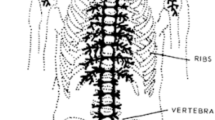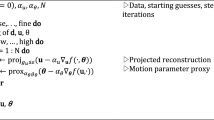Abstract
The objective of this study was to develop an automatic image registration technique capable of compensating for kidney motion in renal perfusion MRI, to assess the effect of renal artery stenosis on the kidney parenchyma.
Materials and methods
Images from 20 patients scheduled for a renal perfusion study were acquired using a 1.5 T scanner. A free-breathing 3D-FSPGR sequence was used to acquire coronal views encompassing both kidneys following the infusion of Gd-BOPTA. A two-step registration algorithm was developed, including a preliminary registration minimising the quadratic difference and a fine registration maximising the mutual information (MI) between consecutive image frames. The starting point for the MI-based registration procedure was provided by an adaptive predictor that was able to predict kidney motion using a respiratory movement model. The algorithm was validated against manual registration performed by an expert user.
Results
The mean distance between the automatically and manually defined contours was 2.95 ± 0.81 mm, which was not significantly different from the interobserver variability of the manual registration procedure (2.86 ± 0.80 mm, P = 0.80). The perfusion indices evaluated on the manually and automatically extracted perfusion curves were not significantly different.
Conclusions
The developed method is able to automatically compensate for kidney motion in perfusion studies, which prevents the need for time-consuming manual image registration.






Similar content being viewed by others
References
Huang AJ, Lee VS, Rusinek H (2004) Functional renal MR imaging. Magn Reson Imaging Clin N Am 12:469–486
Tullus K, Brennan E, Hamilton G, Lord R, McLaren CA, Marks SD, Roebuck DJ (2008) Renovascular hypertension in children. Lancet 371:1453–1463
Hiorns MP, McLaren CA, Gordon I (2008) Renovascular hypertension. In: Fotter R (ed) Pediatric uroradiology. Springer, Berlin, pp 415–420
Safian RD, Textor SC (2001) Renal-artery stenosis. N Engl J Med 344:431–442
Zöllner FG, Monssen JA, Rørvik J, Lundervold A, Schad LR (2009) Blood flow quantification from 2D phase contrast MRI in renal arteries using an unsupervised data driven approach. Z Med Phys 19:98–107
Michaely HJ, Schoenberg SO, Oesingmann N, Ittrich C, Buhlig C, Friedrich D, Struwe A, Rieger J, Reininger C, Samtleben W, Weiss M, Reiser MF (2006) Renal artery stenosis: functional assessment with dynamic MR perfusion measurements–feasibility study. Radiology 238:586–596
Tullus K (2011) Renal artery stenosis: is angiography still the gold standard in 2011? Pediatr Nephrol 26:833–837
Schoenberg SO, Rieger JR, Michaely HJ, Rupprecht H, Samtleben W, Reiser MF (2006) Functional magnetic resonance imaging in renal artery stenosis. Abdom Imaging 31:200–212
Michaely HJ, Oesingmann N (2007) Imaging of renal perfusion. In: Schoenberg SO, Dietrich O, Reiser MF (eds) Parallel imaging in clinical MR applications. Springer, Berlin, pp 441–448
Michoux N, Vallée J-P, Pechère-Bertschi A, Montet X, Buehler L, Beers BE (2006) Analysis of contrast-enhanced MR images to assess renal function. Magn Reson Mater Phy 19:167–179
Besl PJ, McKay HD (1992) A method for registration of 3-D shapes. IEEE T Pattern Anal 14:239–256
Thorndyke B, Schreibmann E, Koong A, Xing L (2006) Reducing respiratory motion artifacts in positron emission tomography through retrospective stacking. Med Phys 33:2632–2641
Lujan AE, Balter JM, Ten Haken RK (2003) A method for incorporating organ motion due to breathing into 3D dose calculations in the liver: sensitivity to variations in motion. Med Phys 30:2643–2649
Pluim JP, Maintz JB, Viergever MA (2003) Mutual-information-based registration of medical images: a survey. IEEE T Med Imaging 22:986–1004
Pluim JPW, Antoine Maintz JB, Viergever MA (2000) Interpolation artefacts in mutual information-based image registration. Comput Vis Image Underst 77:211–232
Studholme C, Hill DLG, Hawkes DJ (1999) An overlap invariant entropy measure of 3D medical image alignment. Pattern Recogn 32:71–86
Marinelli M, Positano V, Tucci F, Neglia D, Landini L (2012) Automatic PET-CT Image registration method based on mutual information and genetic algorithms. Sci World J 2012:567067
Takemura A, Suzuki M, Sakamoto K, Kitada T, Iida H, Okumura Y, Harauchi H (2008) Analysis of respiration-related movement of upper abdominal arteries: preliminary measurement for the development of a respiratory motion compensation technique of roadmap navigation. Radiol Phys Technol 1:178–182
Song R, Tipirneni A, Johnson P, Loeffler RB, Hillenbrand CM (2011) Evaluation of respiratory liver and kidney movements for MRI navigator gating. J Magn Reson Imaging 33:143–148
Lietzmann F, Zöllner FG, Attenberger UI, Haneder S, Michaely HJ, Schad LR (2012) DCE-MRI of the human kidney using BLADE: a feasibility study in healthy volunteers. J Magn Reson Imaging 35:868–874
Jhooti P, Keegan J, Firmin DN (2010) A fully automatic and highly efficient navigator gating technique for high-resolution free-breathing acquisitions: continuously adaptive windowing strategy. Magn Reson Med 64:1015–1026
Li S, Zöllner FG, Merrem AD, Peng Y, Roervik J, Lundervold A, Schad LR (2012) Wavelet-based segmentation of renal compartments in DCE-MRI of human kidney: initial results in patients and healthy volunteers. Comput Med Imag Graph 36:108–118
Positano V, Santarelli MF, Landini L (2003) Automatic characterization of myocardial perfusion in contrast enhanced MRI. EURASIP J Adv Sig Pr 5:413–421
Zöllner FG, Sance R, Rogelj P, Ledesma-Carbayo MJ, Rørvik J, Santos A, Lundervold A (2009) Assessment of 3D DCE-MRI of the kidneys using non-rigid image registration and segmentation of voxel time courses. Comput Med Imag Graph 33:171–181
Rogelj P, Kovačič S (2006) Symmetric image registration. Med Image Anal 10:484–493
Hodneland E, Kjorstad A, Andersen E, Monssen JA, Lundervold A, Rorvik J, Munthe-Kaas, A (2011). In vivo estimation of glomerular filtration in the kidney using DCE-MRI. In: Proceedings of the 7th international symposium on image and signal processing and analysis (ISPA), pp 755–761
Rogelj P, Kovačič S, Gee JC (2003) Point similarity measures for non-rigid registration of multi-modal data. Comp Vis Image Und 92:112–140
Rogelj P, Zöllner FG, Kovačič S, Lundervold A (2007) Motion correction of contrast-enhanced MRI time series of kidney. In: Proceedings of the 16th IEEE international electrotechnical and computer science conference, pp 191–194
Author information
Authors and Affiliations
Corresponding author
Rights and permissions
About this article
Cite this article
Positano, V., Bernardeschi, I., Zampa, V. et al. Automatic 2D registration of renal perfusion image sequences by mutual information and adaptive prediction. Magn Reson Mater Phy 26, 325–335 (2013). https://doi.org/10.1007/s10334-012-0337-4
Received:
Revised:
Accepted:
Published:
Issue Date:
DOI: https://doi.org/10.1007/s10334-012-0337-4




